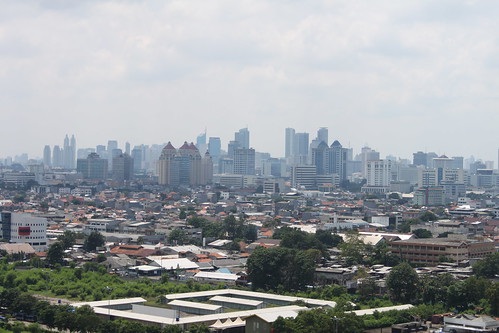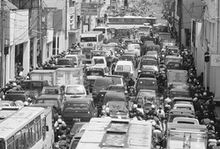Jakarta Annual Flooding in February 2011
Since I started this blog in January 2007, I have recorded all floods in Jakarta in this blog. Interestingly, the worst floods occured in Jakarta during the month of February when rainfall in Jakarta and other areas in Indonesia was at its highest and floods become a threat for residents.
In February 2007, the flood inundated about 70 per cent of the Jakarta's area. It killed at least 57 people and sent about 450,000 fleeing their homes. The city's hospitals struggled with an influx of patients suffering from diarrhoea, dengue and severe respiratory problems. The flood paralysed the centre of Indonesia's economy for several days and businesses claimed to lose about US$1 billion.
In February 2008, 37 of 267 subdistricts in Jakarta were inundated by more than 40 centimeters of water. Floodwaters caused public transportation, including the busway lines across Jakarta, to stop operations, leaving thousands of passengers stranded. The flood also inundated the Sedyatmo toll road to Soekarno-Hatta International Airport, which resulted in the cutting off the highway for a few days. Nearly 1,000 flights were delayed or diverted and 259 flights were canceled.
In February 2009, the floods inundated many parts of Jakarta including sub-districts Bidara Cina, Kampung Melayu, Cawang, Bukit Duri, Angke, Petamburan, Tanjung Priok, Kelapa Gading, Koja, Cilincing, Rawa Badak, Kamal Muara, and Kapuk Muara. These areas were inundated by between 10 and 50 centimeters of water. Floodwaters also caused lengthy traffic jams in many main streets in Jakarta.
In February 2010, the floods inundated more areas than the previous year’s floods despite a lower level of rainfall. The flood in February 2010 also killed at least 2 people and displaced more than 1,700 in Kampung Melayu, Bukit Duri and Bidaracina areas from overflowing Ciliwung river.
In February 2011, the worst flood inundated Jakarta on February 15, 2011 that caused severe flooding in the neighborhood of Jl. Gunung Sahari and a 50-centimeter-deep flood that submerged the main road connecting Mangga Dua Square and the Ancol amusement park. The flooding also affected TransJakarta buses bound for Ancol (The Jakarta Post, February 16, 2011).
The East Flood Canal project has been completed and reached the sea on December 31, 2009. This massive project was considered as the most feasible solution for preventing future floods in Jakarta, but it clearly cannot prevent the flooding entirely. Neither dredging the canals and rivers nor building new canals is a sustainable solution for preventing future flooding in Jakarta. The annual floods are strong evidence that Jakarta cannot sustainably accommodate its rapid growth.
Two children chased each other cheerfully, splashing about in polluted water flowing through a small alley in Muara Angke, Pluit, in North Jakarta, while their mother watched television in their home nearby. Their mother, Carini, in an effort to stop water from flooding their home, had deployed a few sacks of charcoal as a barrier. After all, she made no bones about the floodwaters that regularly inundate her home. She and her family members had already made peace with the floods, she told The Jakarta Post.
“We even use floodwater to wash our clothes if the water looks clean,” she said. Carini knows by heart what time the water will start rising.
“Every day the water rises at 8 a.m. until around 10 or 11 p.m,” she said, adding that the water could at times be ankle-high.
Before she decided to elevate her home’s floor last year, floodwaters had been as much as 1 meter high. Carini has been living in the fishing village of Muara Angke for the past 12 years, and insists she will remain there in spite of the perennial inundation. Her home is where their livelihood is as her husband is a fisherman who sets sail from the seaside village.
Muara Angke is one of 27 sites in North Jakarta that are prone to tidal flooding, including Penjaringan, Kapuk Muara, Tanjung Priok and Ancol. The frequent flooding occurs because the elevation of the fishing village is slightly lower than sea level. Compounding the problem is the mounds of garbage that block the passage of water in nearby streams. Sumri, a food vendor at the nearby Muara Angke traditional market, said the aqueduct that channels tidewater was clogged with garbage.
“[The flooding] has never subsided. The best we can hope for is ankle-high flooding,” she said. Sumri said although she and her family were used to the flooding, it could be very disruptive at times, especially during bathing hours.
“My toilet is in the back of the house, so I have to pass the water every time I go there,” she said.
Subandi, Sumri’s brother-in-law who also lives in the home together with his wife and son, said the toilet was 30 meters away.
“To avoid any skin problems we always wash our feet after returning from the toilet,” he said.
Sumri said living so close to water also forced them to spend more on water. She buys clean water once every two days. “We need it for drinking and cooking.”
Despite the persistent garbage, the authorities have done little. “I can’t remember the last time the aqueduct was cleaned. The last time it was cleaned was when the head of the neighborhood initiated a cleanup,” Subandi said.
“I don’t think the subdistrict administration wants to do a cleaning job,” he said, laughing.
The lack of initiative from the local government has prompted residents to deal with the flooding on their own. On Jl. Cumi, an alley next to the Pluit Port that is regularly flooded, residents built an embankment from debris they collected to stop tidal water from flowing into their neighborhood.
The above story illustrates the responsiveness of the Jakarta's residents to flooding. They are the victims and also the "real solution" to the annual flooding in Jakarta. They are willing to sacrifice their life for finding the solution to the annual flooding. It's sad but this is what has been happening in Jakarta for years.





2 comments:
It is interesting to note that the aqueduct was clogged with garbage, and "...the authorities have done little" to ease the clogging. Well, may be if there is no garbage on Jakarta's waterways, there is no un-clogging to do by anyone! I had been to Kepulauan Seribu and watch, in horror, the amount of garbage floating on the sea. You can see queen-sized mattress below piles of plastic bags and everything else. I was planning to take the picture later, but in half an hour, everything has gone, no garbage in sight! That's why people forget to throw garbage correctly, because once you throw it away, you will not see it again. And sadly, Indonesian people are the best people I know in NIMBY attitude.
Perhaps it is about time to wake people up on their responsibility of not to throw garbage to the river or any other place than the garbage bin! What ever happened to Community Participation, or People's Power? Perhaps the authorities should concentrate less on solving the problem at hand, and start to focus on preventing the problem from appearing in the first place. Waste management might be a good point to start because it will inevitably involve people and communities. Authorities had less and less power, especially in contemporary Indonesia. Should the balance fall to the private sectors, or the communities, it is for us to answer.
Im stunned.....
Post a Comment